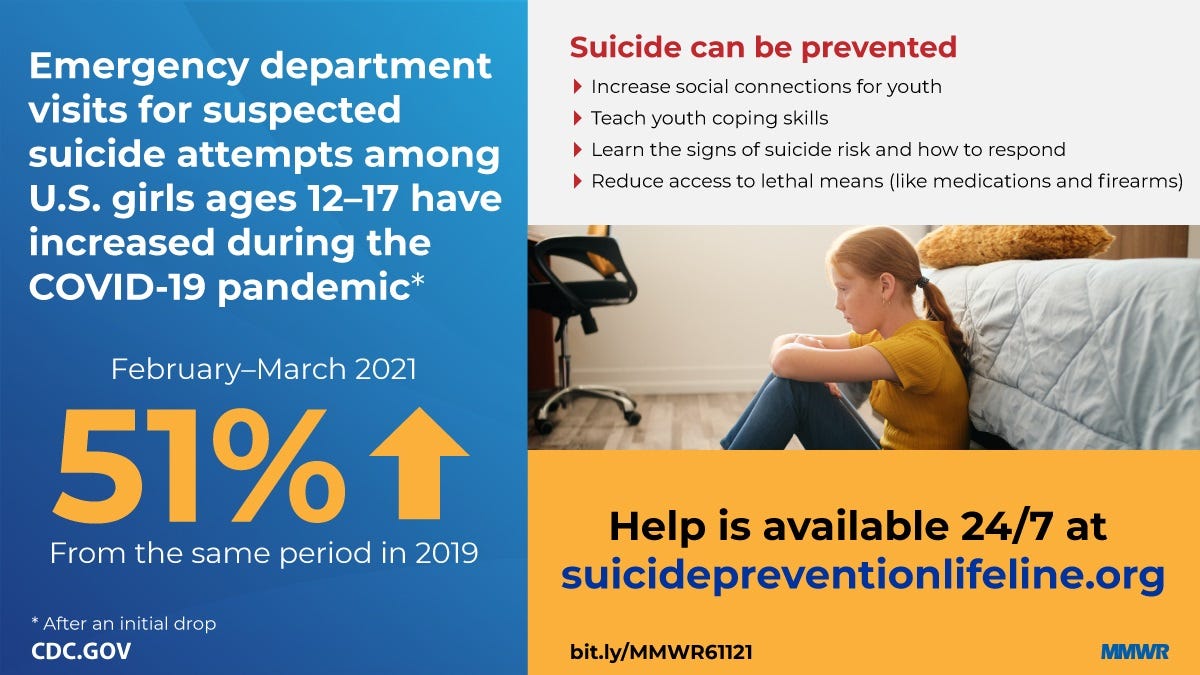
- Hospital visits for suspected suicide attempts rose among teens throughout the pandemic.
- Teen girls were hit hardest, with rates 51% higher in February and March 2021 than the same time in 2019.
- Mitigation measures, isolation, and a disruption of future plans could contribute.
- Visit Insider's homepage for more stories.
The pandemic has taken a dramatic toll on American teens' mental health, with rates of suspected suicide attempts rising since May 2020, new data out of the Centers for Disease Control and Prevention suggests.
Teen girls were hit especially hard. Their suicide attempt rates reached a peak in February and March of 2021, though that doesn't mean their suicide death rates increased.
The findings add to previous work showing an increase in mental-related emergency department visits among 12-to-17-year-olds during 2020. Other studies have also showed a stark increase in suicide ideation during the pandemic, particularly among young adults.
Suicide attempts among girls and women are consistently higher than those of boys and men, but "the findings from this study suggest more severe distress among young females than has been identified in previous reports during the pandemic, " the study authors wrote.
The study looked at three distinct phases of the pandemic
To conduct the study, researchers looked at data from the National Syndromic Surveillance Program to identify trends in emergency room visits for suspected suicide attempts between January 1, 2019 and May 15, 2021. They zeroed in on 12-to-25-year-olds, and broke down the findings by sex, looking at three distinct phases of the pandemic.
Early in the pandemic, these ER visits went down, compared to the same time in 2019. This could be because hospitals were overrun by COVID-19 patients, and other people were encouraged to stay home to stay safe.
But when researchers looked at early May 2020, they found visits for suspected suicide attempts had crept up among 12-to-17 year olds, particularly girls. During the summer of 2020, the average weekly visits for suspected suicide attempts among that population was 26.2% higher than that same time in 2019.
Between February 21 and March 20 of this year, the number was 50.6% higher.

CDC
The researchers say their findings might reflect how young people have been hit especially hard by COVID-related precautions that isolated them from friends, school, and mental health services. Increases in substance use and worries about family health and economic problems could have also contributed to suicide risk. The pandemic exacerbated child abuse and neglect, too.
It's possible, the study authors say, that the rates don't actually reflect more suicide attempts, but rather more hospital visits because of them. Parents home with children may be more apt to notice and take their kids to the emergency room.
But past research suggests it's deeper than that. In an August report out of the CDC, over 25% of 18-to-24-year-olds reporting seriously contemplating suicide in June 2020. Other reports have suggested that adolescents and young adults are the age group suffering most during the pandemic due to social isolation, a lack of independence, and the unknown about a future that once seemed bright.
"A number of kids are expressing that these are supposed to be the best years - high school and college - the most free years," Anne Marie Albano, a professor of medical psychology in psychiatry at Columbia University Irving Medical Center in New York, told the Wall Street Journal last summer. "The possibility that COVID is going to completely change this period of their life, and they won't ever get it back, is overwhelming for a lot of them," she says.
But, as Dr. Alex Crosby, chief medical officer in the CDC's Division of Injury Prevention, said during an Association of Healthcare Journalists fellowship in May, "it's never just one thing."
"It's oftentimes the clinical depression along with substance abuse, along with some other things that might have to do with a financial problem or a relationship problem, or a school problem - that interaction of various factors are generally going put somebody at risk for suicide," he said.
Suicidal behaviors are preventable
The study had some drawbacks: It wasn't nationally representative, nor could it analyze racial and ethnic differences. Hospital systems and states aso have different coding and reporting systems, which could have skewed the results. Follow-up visits for suicide attempts could be coded as initial suicide attempt visits, potentially making the rates seem higher than they actually are.
Still, the findings emphasize the need for improved suicide prevention measures targeted toward teens.
"There is a broad responsibility that communities can work together," Crosby said.
Businesses, places of worship, public health services, schools, hospitals, and the criminal justice system all "have a role to play," he said. "No one person or one group can do it all on its own."
Insider's Hilary Brueck contributed to this report.

